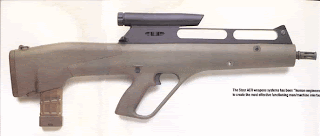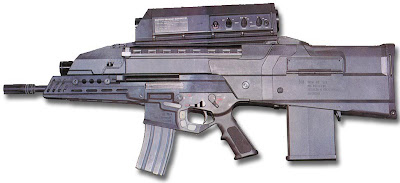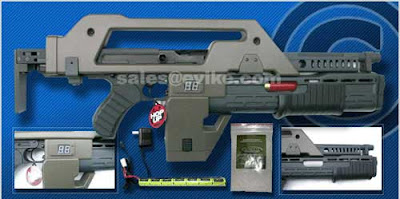The initial design work for the
Heckler & Koch G-11 Bullpup Assault Rifle began in 1969, in response to a German Army request for a new rifle with a high first-round hit-probability, even when fired on automatic, yet would be light, compact, and extremely resistant to harsh climates. Many designs came and went, but by the late 1980s, Heckler and Koch presented the G-11 in final form. The G-11, though reportedly a very effective weapon, suffered from rumors that the ammunition could cook off, that it’s construction made maintenance difficult for both armorers and users, and that it’s looks and design were so exotic as to assault the sensibilities of traditional weapons. In addition, it did not fire 5.56mm NATO ammunition, which was a cardinal sin in NATO at the time.
On top of this came the reunification of Germany, and the massive amounts of AKM and AK-74-type weapons the former East German Army already had available. Finally, the
G-11 Assault Rifle was going to be an expensive weapon to produce, and retooling for series production would take even more expense. By 2006, despite reports of very limited use by special operations forces in various countries, the G-11 is largely a curiosity piece, found mainly in museums or gun collections.
The
Heckler & Koch G-11 Assault Rifle was a revolutionary design, almost completely encased in plastic composites, with 50-round composite magazines that were sealed in plastic until they were loaded. Operation is by gas with a hint of blowback, with a cocking "dial" on the side of the stock and a fire selector above the pistol grip. Original G-11’s had selector settings for safe, semiautomatic, 4-round burst, and fully automatic. Once a magazine is loaded into the
H&K G-11 Assault Rifle (slid into a track atop the handguard), the rounds face downward, and rounds are pushed downwards into the breech/chamber. The breech/chamber then rotates 90 degrees to line up with the 21.26- inch barrel. The cocking "dial" does not move when the G-11 fires, and can also be used as a decocker. The magazine moves back and forth in its track as the rifle fires; this actually helps dampen recoil, along with some other recoil-dampening mechanisms inside the G-11.
When firing on full automatic, the cyclic rate is rather slow, at about 600 rpm; but when on burst, the cyclic rate rises to over 2000 rpm so fast that the fourth round is well downrange before the recoil from any of the rounds is felt. (This kind of burst feature served as a model for future burst-firing weapons, and is now quite common on such weapons.)
This makes bursts extremely accurate and virtually immune to barrel climb. There is, of course, no spent case ejection, but dud rounds are automatically ejected from a port with a hinged cover under the "receiver." This port closes again after the round is ejected. The "receiver" is topped with a carrying handle that contains a simple 1x aiming tube with a Mil-Dot reticule, with provisions for the removal of this aiming tube and replacement with a special 3.5x scope or certain other optics. The G-11 is also a very compact assault rifle, only a little over 29.5 inches long, despite the length of its barrel. The barrel is tipped by a cylindrical flash suppressor. The original version of the
G-11 Assault Rifle had no provision for the mounting of a bayonet, but this was quickly rectified. Heckler & Koch went through a number of prototypes over the intervening years, but the initial production model was supposed to be the G-11K2
Assault Rifle ; this model used 45-round magazines, but there were three mounted above the handguard (which was also larger, rounded on the bottom, and otherwise rather squarish).
(The
Heckler & Koch G-11K2 Assault Rifle is still capable of being loaded with the original 50-round magazines, but they will not fit into the spare magazine tracks on the sides of the loaded magazine.) One of these magazines was to be carried inserted into the rifle, with the other two on separate tracks on either side of the inserted magazine to allow for quick magazine changes. The three magazines were carried lower on the top of the handguard than on the original G-11. A locking slot for a special bayonet was added, and the cylindrical flash suppressor was replaced by semi-flash suppressor combined with a muzzle set well back from the front of the weapon, effectively doing the same job. The carrying handle was replaced with one which could be completely removed, with a mount for various NATO-compatible optics. (A future modification was to include a length of MIL-STD-1913 rail).
The burst setting was changed from four to three rounds, to simplify the fire mechanism. A number of other mechanical and ergonomic modifications were also carried out, and the shape of the G-11K2 is
very different from that of the original G-11. Of course, the most revolutionary aspect of the G-11 is its ammunition, which is caseless. The bullet and combustible primer is embedded in a block or propellant, and nothing needs to be ejected after firing; there is no spent brass. The ammunition is therefore extremely light in weight and compact in size, allowing for a large magazine capacity without undue weight or magazine size. (I personally think this sort of ammunition for small arms may be the wave of the near future, but that’s just my opinion).
When the US military announced its competition for the ACR (Advanced Combat Rifle), Heckler and Koch sent some
Heckler & Koch G-11K2s for that competition, where it picked up monikers like "space rifle" and "plastic plank," despite the fact that the troops testing the G-11 liked its performance and compact size. However, the US military had such a large investment in M-16-type weapons, and especially in the 5.56mm NATO cartridge, at the time of testing, which was probably the biggest reason for its ultimate rejection. Twilight 2000 Notes: Production of the G-11 began very rapidly in 1990, and just as quickly slowed in 1991; by 1994, Heckler & Koch were concentrating on the G-41 and then-upcoming G-36. Despite some 20,000 examples of the G-11 being made, by 2000, most of them had been discarded as pre-war stocks of ammunition were largely expended and new stocks were almost impossible to make using the production methods available by 2000.
Merc 2000 Notes: This is a popular weapon for special ops forces operating in harsh climates. If you encounter a force armed with the G-11, they are probably clandestine forces of a large national government or of someone who has a lot of money to spend on exotic weapons and ammunition.

























































